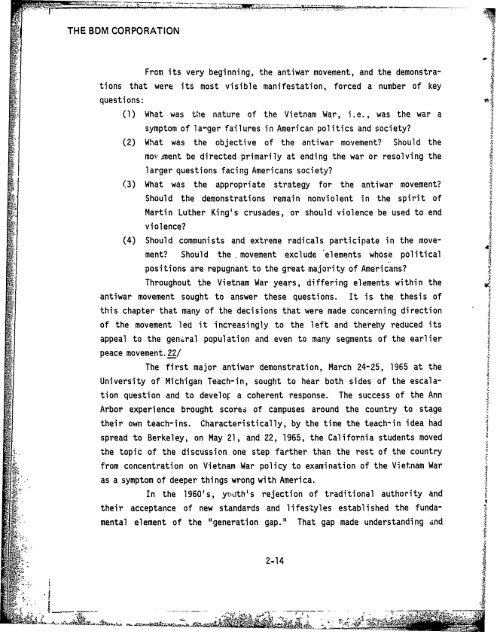policy - The Black Vault
policy - The Black Vault
policy - The Black Vault
You also want an ePaper? Increase the reach of your titles
YUMPU automatically turns print PDFs into web optimized ePapers that Google loves.
THE BDM CORPORATION<br />
and the demonstrations<br />
that were<br />
questions:<br />
From its very beginning, the antiwar movement,<br />
its most visible manifestation, forced a number of key<br />
(1) What was the nature of the Vietnam War, i.e., was the war a<br />
symptom of larger failures in American politics and society?<br />
(2) What was the objective of the antiwar movement? Should the<br />
mov ;ment be directed primarily at ending the war or resolving the<br />
larger questions facing Americans society?<br />
F (3) What was the appropriate strategy for the antiwar movement?<br />
Should the demonstrations remain nonviolent in the spirit of<br />
Martin Luther King's crusades, or should violence be used to end<br />
violence?<br />
(4) Should communists and extreme radicals participate in the movement?<br />
Should the . movement exclude elements whose political<br />
positions are repugnant to the great majority of Americans?<br />
Throughout the Vietnam War years, differing elements within the<br />
antiwar movement sought to answer these questions. It is the thesis of<br />
this chapter that many of the decisions that were made concerning direction<br />
of the movement led it<br />
increasingly to the left and thereby reduced its<br />
appeal to the general population and even to many segments of the earlier<br />
peace movement. 22/<br />
<strong>The</strong> first major antiwar demonstration, March 24-25, 1965 at the<br />
University of Michigan Teach-in, sought to hear both sides of the escalation<br />
question and to develop a coherent response. <strong>The</strong> success of the Ann<br />
Arbor experience brought scores of campuses around the country to stage<br />
their own teach-ins. Characteristically, by the time the teach-in idea had<br />
spread to Berkeley, on May 21, and 22, 1965, the California students moved<br />
the topic of the discussion one step farther than the rest of the country<br />
from concentration on Vietnam War <strong>policy</strong> to examination of the Vietnam War<br />
as a symptom of deeper things wrong with America.<br />
In the 1960's, yulth's rejection of traditional authority and<br />
their acceptance of new standards and lifestyles established the fundamental<br />
element of the "generation gap."<br />
That gap made understanding and<br />
2-14<br />
V
















